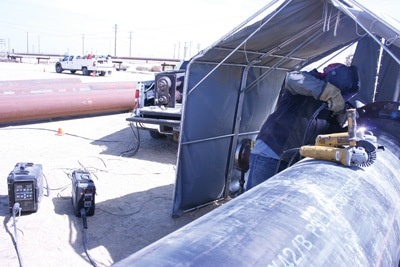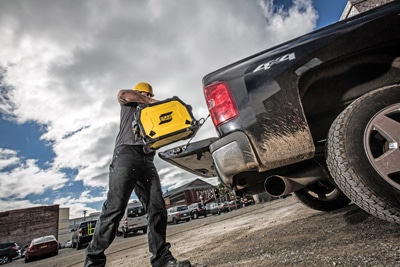Advances in Point-of-Use Controls and Portability Drive Commercial Construction Welding
Welding equipment in commercial building applications (think structural steel, HVAC, building MRO, etc.) has evolved in recent years with one general goal: Put control over the welding arc immediately next to the operator. On jobsites where welding may be taking place hundreds of feet and numerous levels away from where a welding power source can be stationed, this has three primary benefits: productivity, quality and safety.
With higher-output industrial power sources this has been achieved through advances in remote control, weld cable and wire feeder technology. For lower-output welding applications, where 200 amps or less will typically get the job done, new products by ESAB and Miller Electric have built considerable multi-process performance into portable models about the size of a traditional wire feeder. And some of these can plug into standard 120- or 230-V power via multi-voltage plugs for complete jobsite flexibility.
Advantages of Point-of-Use Controls/Portable Multiprocess Units
Productivity: If a welding operator can spend more time working and less time getting up and changing settings back at a power source that could be 200 ft away, then they will get more work done. It’s also possible they can get distracted talking with colleagues or doing other tasks while making that trip. It increases the percentage of the day dedicated to productive work.
Quality: No self-respecting professional would ever admit it, but if making a setting change requires the operator to take a long walk back to a power source, they might choose to “make do” with the settings they currently have, leading to an inferior weld.
Safety: Allowing an operator to change parameters at the point of use eliminates their exposure to any jobsite hazards that might be present when traveling between the work area and the power source. Tripping, equipment, angry foremen, etc.
Industrial-Grade Point-of-Use Controls Now for Inverters and Engine Drives

Having control over weld parameters and processes right at the joint is critical in many construction applications, including pipe welding.
Remote control capabilities are not new, per se — but what is relatively new is the ability to remotely control voltage/amperage and wire feed speed at the point of use, as well as the ability to switch processes with some units. In the past, a welder could remotely control voltage at the wire feeder, but it required an additional control cable to stretch back from the feeder to the power source. These cables are expensive, are another “consumable” prone to wear and tear and present an additional tripping hazard.
Miller Electric Mfg. Co. first began to tackle this issue with the introduction of wireless controls for TIG and MIG/Flux Cored processes that plugged into the power source via a 14-pin receiver. The manufacturer then introduced ArcReach technology for its inverter-based XMT systems, which allowed for voltage and wire feed speed to be controlled at the wire feeder without the need for an extra cable. Lincoln Electric now offers the same capability through its new CrossLinc Technology, introduced in January for its Flextec 350X power source and LN-25X wire feeder.
“The technology allows the welding power source to send voltage control commands to the feeder across the common welding cable that customers already have in their fleet,” says Matt Albright, product manager for welding equipment, Lincoln Electric. “The result is greater safety, quality and productivity for jobsite and fab shop environments.”
But what if you could also change processes at the point of the weld joint? Miller has recently introduced its “Smart Feeder” technology — first for inverter-based systems in pipe welding applications and now for engine-driven welder/generators used in both pipe and general construction applications. In addition to the ability to change processes, the feeder also puts advanced welding processes (RMD and Pulsed MIG) into the hands of the operator if needed.
“Customers were looking to get complete control over the weld at the joint,” says Ben Froland, product manager, Miller. “They now can run advanced processes for the benefits they provide [quality, higher deposition rates], but they can also adjust voltage and change processes right at the weld joint. They don’t have to make any trips back to the power source — it all communicates right on the weld cable.”
The smart feeder technology also offers another quality advantage: It measures the output at the point of use versus back at the power source. In the past, a welding system could be set one way at the power source, but lose some of that power due to inductance if stretched out over a long stretch of cord — 100 ft, as an example. That would mean the operator may not actually be welding at the parameters they believed they were working at — a quality problem if the code/specs require specific settings. By measuring the output at the point of use, operators can be sure they are welding at the proper parameters.
“The arc performance doesn’t change based on cable inductance,” says Joe Ryan, market segment manager for process pipe solutions at Miller. “Voltage drop affects MIG and Flux Cored processes and is overcome by turning up the voltage at the power source or through a remote to compensate for the drop. Inductance acts like a spring, which degrades the waveform over distances. This is physics and cannot be adjusted. The wave form is generated at the feeder [with this new feeder], and it’s a consistent distance from the wave form generator to the weld joint.”
Transitioning this feeder technology to engine-driven welder generators makes sense for the commercial construction industry, according to Ryan.
“That’s just addressing the lack of availability of primary power on some jobsites,” he says. “The more expansive the jobsite, the less likely it is to have convenient access to primary power. It makes sense to have [this technology] available for both engine drives and plug-in options.”

For light-duty applications, OEMs are now introducing true multiprocess systems that allow for excellent portability around the jobsite — like ESAB’s recently introduced Rebel EMP 215ic.
Portable Systems Tout Industrial-Strength Multiprocess Capabilities
For light-duty applications, OEMs are now introducing true multiprocess systems that allow for excellent portability around the jobsite. As an example, ESAB recently introduced its Rebel EMP 215ic, a 40-lb power source that provides MIG, Flux Cored, Stick and TIG welding in a small, self-contained power source. The unit can plug into 120- or 230-V outlets, wall power or generator, via an easy-to-switch multi-voltage plug. Miller offers similar functionality with its Multimatic 200 power source. The goal of these units is to easily transport an industrial-quality welding arc anywhere on the jobsite that is needed.
“Professional welders wanted a compact, multi-process system that performed as well as an industrial system,” says Doug Smith, product business manager — arc equipment, ESAB. “And contractors, especially smaller ones, want systems that provide flexibility. Units that offer a multi-process output, lightweight portability and input power flexibility provide a better value than stand-alone MIG or Stick/TIG welders.”
Smith references stand-alone, shoulder-carried welding units that have been available for years. What’s new to this product category is the multiprocess functionality and the ability to leverage whatever input power is available on the site.
“The challenges are finding a source of wall power and combating voltage surges and dips that can cause nuisance trips or damage internal components,” says Smith. “When running off generator power, today’s inverters can, depending on the model, provide performance that is indistinguishable from that of wall power, and that includes arc stability and arc characteristics.”
According to Smith, that industrial quality arc holds up, even on tough-to-weld 6010 Stick electrodes common in construction applications.
“The arc performance of the ESAB Rebel matches that of industrial systems,” says Smith. “Welders can manipulate an E6010 electrode and obtain the same type of puddle control that they would from [an industrial system]. The same holds true for tailoring the Hot Start and Arc Force functions for different electrodes, joint configurations and operator preferences.”
Both the new ESAB and Miller systems tout easy-to-set control panels that, depending on the power source and process, can be set to optimal parameters by inputting basic joint information. For instance, the sMIG (smart MIG) functionality on the ESAB unit establishes its welding arc simply by identifying the diameter of wire used and the thickness of the steel to be welded. Operators can still adjust the settings to further fine-tune the arc, depending on process, but the simplicity makes it easier for newer operators to start off on the right foot.
“Experienced welders become productive more quickly, and novice welders start producing quality welds in less time,” says Smith. “[This functionality] takes away the doubt of welding with incorrect settings so users can focus on good gun technique.”



Comments are closed here.